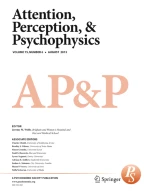Abstract
People can perceive the individual features of an object by focusing attention on it and binding the features together at a location. Some perceptual processing can occur without focusing attention on each object, though; people may even be able to extract summary information about the sizes of all the objects in a display, essentially computing the mean size at a glance. Evidence that people can judge the mean size of an array efficiently and accurately has been used to support the strong claim that people use a global, parallel process to extract a statistical summary of the average size of the objects in the display. Such claims are based both on the accuracy of performance and on the supposition that performance exceeds what would be possible with serial, focused attention. However, these studies typically have not examined the limits of performance with focused-attention strategies. Through experiments and simulations, we show that existing evidence for mean size perception can be explained through various focused-attention strategies, without appealing to a new mechanism of average size perception. Although our evidence does not eliminate the possibility that people do perceive the average size of all the objects in a display, it suggests that simpler mechanisms can accommodate the existing data.
Article PDF
Similar content being viewed by others
Avoid common mistakes on your manuscript.
References
Ariely, D. (2001). Seeing sets: Representation by statistical properties. Psychological Science, 12, 157–162.
Cavanagh, P. (2001). Seeing the forest but not the trees. Nature Neuroscience, 4, 673–674.
Chong, S. C., & Treisman, A. [M.] (2003). Representation of statistical properties. Vision Research, 43, 393–404.
Chong, S. C., & Treisman, A. [M.] (2005a). Attentional spread in the statistical processing of visual displays. Perception & Psychophysics, 67, 1–13.
Chong, S. C., & Treisman, A. [M.] (2005b). Statistical processing: Computing the average size in perceptual groups. Vision Research, 45, 891–900.
de Fockert, J. W., & Marchant, A. P. (2008). Attention modulates set representation by statistical properties. Perception & Psychophysics, 70, 789–794.
Oliva, A., & Schyns, P. G. (2000). Diagnostic colors mediate scene recognition. Cognitive Psychology, 41, 176–210.
Oliva, A., & Torralba, A. (2001). Modeling the shape of a scene: A holistic representation of the spatial envelope. International Journal of Computer Vision, 42, 145–175.
Parkes, L., Lund, J., Angelucci, A., Solomon, J. A., & Morgan, M. (2001). Compulsory averaging of crowded orientation signals in human vision. Nature Neuroscience, 4, 739–744.
Potter, M. C. (1976). Short-term conceptual memory for pictures. Journal of Experimental Psychology: Human Learning & Memory, 2, 509–522.
Rensink, R. A. (2000). Seeing, sensing, and scrutinizing. Vision Research, 40, 1469–1487.
Rensink, R. A. (2004). Visual sensing without seeing. Psychological Science, 15, 27–32.
Sussman, R. S., & Scholl, B. J. (2008). The flexibility of statistical summary representations in vision. Manuscript submitted for publication.
Treisman, A. M., & Gelade, G. (1980). A feature-integration theory of attention. Cognitive Psychology, 12, 97–136.
Watamaniuk, S. N. J., & Duchon, A. (1992). The human visual system averages speed information. Vision Research, 32, 931–941.
Wolfe, J. M., Alvarez, G. A., & Horowitz, T. S. (2000). Attention is fast but volition is slow. Nature, 406, 691.
Author information
Authors and Affiliations
Corresponding authors
Additional information
Experiments 1 and 2 were conducted as part of an undergraduate honors thesis by K.M., who is currently a neuroscience graduate student at the University of California, Irvine. K.M. and D.J.S. jointly designed those experiments, and K.M. was responsible for implementing, conducting, analyzing, and modeling them. He also wrote the initial draft of the manuscript, which did not include simulations of other averaging studies in the literature. D.J.S. was responsible for all of the other simulations and revisions of the manuscript.
Rights and permissions
About this article
Cite this article
Myczek, K., Simons, D.J. Better than average: Alternatives to statistical summary representations for rapid judgments of average size. Perception & Psychophysics 70, 772–788 (2008). https://doi.org/10.3758/PP.70.5.772
Received:
Accepted:
Issue Date:
DOI: https://doi.org/10.3758/PP.70.5.772
